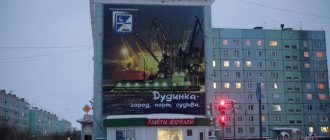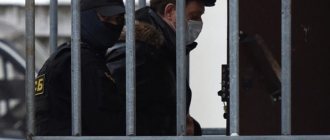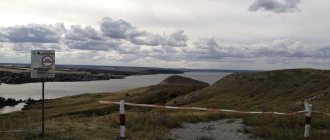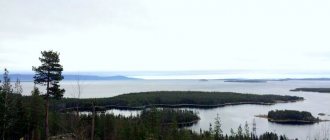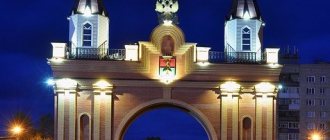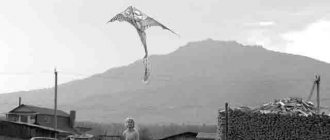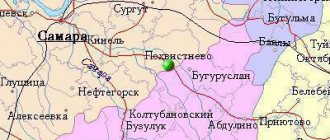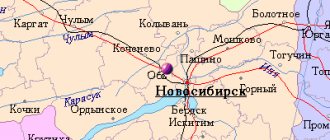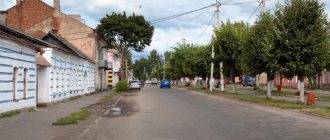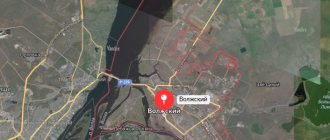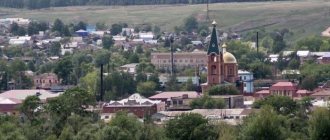“I see Mendeleevsk as a happy, beautiful city that enjoys the love of its residents”
The day before, a session of the district council was held in Mendeleevsk, at which deputies accepted the resignation of head Valery Chershintsev and approved him as acting.
head Radmir Belyaev, who in August of this year became the head of the district executive committee. Immediately after his appointment, Belyaev gave a comment to Tatar-inform news agency. He called the preservation of young people in the city and region a priority. “There is an initiative together with the Ammonia company to strengthen the educational sector, to work to restore the work of the college in terms of personnel training, because Ammonia is a dynamically developing company that has big development plans. This includes the production of fertilizers and the development of agricultural technologies. Therefore, personnel training is a very important point,” he noted.
Another task Radmir Belyaev called the improvement of the territories of the city and region. “Now, together with the Ammonia company, we are working on the design code for the city. We are actively looking for a chief architect to strengthen the improvement work,” shared the agency’s interlocutor.
Radmir Belyaev called the improvement of the territories of the city and region one of his tasks
Photo: mendeleevsk.tatarstan.ru
Also in the priority plans is to reform the activities of the housing and communal services sector. The reform will be associated with improving the services provided to the population. Work will also be strengthened on the quality of work performed under the presidential program “Our Yard”.
In addition, Radmir Belyaev’s team will work on the development of small and medium-sized businesses, agriculture, attracting investment projects, development of PASED, transport and logistics industrial park “Mendeleevsk 2.0” and other projects.
“At the moment, my team and I are forming a concept for the development of the city and region for the next five years, coordinating it with the city-forming enterprises and the leadership of the republic, and will soon present it to the public,” the acting acting director shared his plans. heads of the district.
In the future, Radmir Belyaev sees Mendeleevsk as a comfortable city, comfortable for living. “The potential is huge: Chelny and Yelabuga are nearby - such proximity provides opportunities for our Mendeleevsk. We will move actively in all areas, attracting the necessary experts, taking advantage of federal programs and republican support,” Belyaev noted.
“Efforts will be intensified on the quality of the work of the presidential program “Our Yard”
Photo: mendeleevsk.tatarstan.ru
History of the city of Mendeleevsk
Mendeleevsk (Mendeleev) is a city of regional subordination, the center of the Mendeleevsky district. Located in the north-eastern part of the Republic of Tatarstan, on the right bank of the river. Kama, 8 km north of the railway. Art. Tikhonovo (Agryz–Akbash line). The distance to Kazan is 238 km. Area 14.1 sq. km.As of 2002 - 22 thousand inhabitants, incl. Tatars - 55.1%, Russians - 36.1%, Udmurts - 2.4%, Maris - 2.4%.
Chemical plant named after. L.Ya. Karpov, LLC "Mendeleevskazot" (see "Tatazot"), bakery, furniture factory. 2 vocational schools, 4 secondary schools, 3 gymnasiums, 1 children's art school, palace of culture, local history museum, 3 libraries. Church, mosque.
Modern Mendeleevsk was formed in 1967 as a result of the merger of the town of Bondyuzhsky, village. Lenino (until the beginning of the 1920s - the village of Mirnoye Pristanishche, Kamashevo), village. Quiet Mountains, Bondyuga village. Quiet Mountains and the village of Bondyuga were founded in the 2nd half of the 17th century. on lands that belonged to the Sedmiozernaya Hermitage; village Mirnoe Pristanishche - in 1801 by landowner I.N. Kamashev, populated by peasants transferred from the Moscow, Vladimir and Kazan provinces.
According to information from 1834, in the village of Bondyuga there were 420 male souls, in the village of Mirnoye Pristanishte - 373, in the village. Quiet Mountains - 766.
In 1867, breeder P.K. Ushkov bought Kamashev’s estate, founding a chemical plant and a village attached to it in 1868. From that time on, work at the plant became the main source of livelihood for many peasants in the surrounding villages, and the settlements themselves became part of the enterprise’s infrastructure (cargo arrived and departed through the pier in the village of Tikhie Gory; in the village of Mirnoye Pristanishte there was the Ushkov estate, the apartments of directors and engineers) .
By the beginning of the 20th century. The plant's village, which grew into a large settlement for its time (3,001 people in 1897), was given the name Bondyuzhsky. In 1896, a Russian-Tatar school was opened here, in 1898 - a Russian factory school, and in 1906, a mosque was built with funds from the factory. Orthodox residents of Bondyuzhsky and other settlements were parishioners of the Epiphany Church in the village. Quiet Mountains.
Since 1868, a zemstvo school operated in the village, and there was a similar educational institution in the village of Bondyuga (since 1896). According to the 1897 census, in the village. There were 789 people living in Quiet Mountains, 473 in the village of Bondyuga, and 373 in the village of Mirnoe Pristanishte.
At the turn of the 19th–20th centuries. plant P.K. Ushkova has become one of the leading enterprises in the Russian chemical industry. The scientific consultant of the plant was D.I. Mendeleev. In June–August 1893, he established the production of smokeless gunpowder here. Among the managers of the enterprise in the pre-revolutionary period were famous chemist-technologists B.I. Zbarsky, L.Ya. Karpov. In 1916–17 the writer B.L. worked in the military registration desk of the plant. Parsnip.
Until 1921 the village. Bondyuzhsky (and the settlements associated with it) was part of the Kurakovsky volost of the Elabuga district of the Vyatka province; from 1921 as part of the Elabuga, from 1928 - Chelny cantons of the Tatar Autonomous Soviet Socialist Republic. In 1921–25 in the village Bondyuzhsky operated the first radium plant in the USSR, which played an important role in the development of domestic nuclear physics. On May 21, 1928, Bondyuzhsky received the status of a workers' settlement (settlement), and on August 10, 1930, it became the center of the newly formed Bondyuzhsky district. With the abolition of the latter (01/20/1931), the village became part of the Yelabuga region. On February 10, 1935 it was restored as a regional center. On 02/01/1963, as a result of the consolidation of the administrative units of the TASSR, it again came under the control of the Yelabuga region. On 08/11/1967 it was transformed into the city of Mendeleevsk, from 08/15/1985 the center of the Mendeleevsky district.
Monuments of industrial, religious and civil architecture of the 19th and early 20th centuries have been preserved in Mendeleevsk. (including the Epiphany Church, built in 1818–35, the office building of the Bondyuzhsky plant - in 1870, etc.). A landmark of the city is secondary school No. 4 (former secondary school No. 1 in the Bondyuzhsky town), among whose graduates are 6 Heroes of the Soviet Union (V.I. Belousov, V.I. Burmistrov, V.G. Piskunov, P.S. Safronov, M.V. Sudnishnikov, M.S. Fomin).
Number of inhabitants (before 1967 - Bondyuzhsky, since 1967 - Mendeleevsk): in 1920 - 3.7, in 1926 - 5.2, in 1938 - 8.7, in 1970 - 13.6, in 1979 - 13.8, in 1989 - 18.2 thousand people.
The first settlements on the territory of the city appeared in the first millennium BC. This is confirmed by the hotels located 3 km away. to the northeast of the village of Tikhye Gory there is a fortification and settlement of the Ananino cultural and historical community (the beginning of the Iron Age). The area of the settlement (70 m) occupies a cape between two ravines, which made it easier to defend the settlement from enemy attacks. On the side equal to the ground level, the fort was protected by a moat and a high earthen rampart, along the crest of which wooden fortifications were placed, from where residents could repel attacks. The settlements served as a refuge for both the population and livestock. Depending on their size, they could accommodate from 80 to 200 people.
The settlement, formerly a village, Tikhie Gory was founded in the second half of the 17th century. According to an archival certificate provided by the Main Archive of Moscow, “the hegumen of Semiozernaya was granted the desert (monastery) Hilarion, an empty roadable land that is known as the Quiet Mountains. In the village in 1681 there was a monastery courtyard, where a janitor lived with 2 children, 14 bobyl households, where 15 bobyls (landless peasants - Ozhegov’s Dictionary) and 14 of their children and nephews lived, and a monastery groom with his son (only men were counted ). In the village there were priests, sextons and prosvernitsa. Accordingly, the village of Quiet Mountains was formed between 1673-1677. In 1747, 202 males lived in the village.
Bondyuga
Bondyuga - translated from Udmurt means “a lot of small water, springs” (according to L. Arslanov). According to data for 1887 from the Kirov State Archives, Bondyuga was founded in the 17th century, during the period when the territory of the region began to be settled by Russians from the northern regions of the Vyatka province, which had been previously developed by the Novgorod ushkuiniki. Until 1764 Bondyuga belonged to the Kazan Sedmiozernaya hermitage (monastery), later it belonged to the economic hermitage, and from 1841 it belonged to the state. It was part of the Kurakovo volost. In 1896 there was a zemstvo school here; before that, children went to school at the Bondyuzhsky plant.
As of 1887, 490 people lived in the village, of which 240 were male, including 41 literate people. There were 61 books in the village. The proximity to an industrial enterprise influenced the way of life of the villagers. On the one hand, factory workers are consumers of agricultural products, on the other, the plant had a positive impact on the culture of the villagers.
The area of the villages of Bondyuga and Makarovo was a gathering place for the forces of the White Guard Army before the assault on the Bondyuzhsky plant, as evidenced by the finds of shells, parts of guns and weapons.
The general reconstruction of the KhZK at the beginning of the twentieth century, and then the largest construction projects in neighboring cities, greatly influenced economic temptations. Village residents began to move to the city. Bondyuga increasingly turned into a place of residence for old people, now into a holiday village within the city.
Kamashev and the Ushkov estate
End of the 18th century - the reign of Emperor Paul I, who sought to strengthen the nobility by giving away land plots. Thus, collegiate assessor Nikolai Ivanovich Kamashev was granted land near the Toyma River and peasants from Moscow, Kazan, Yaroslavl and other provinces. Having become the rightful owner of the gifts, Kamashev subsequently behaved like a landowner who wished, having established himself in a new place, to restore his order.
In the first half of the 19th century.
on a hill, by his order, a wooden house was being built, from where a new village was clearly visible - Peaceful Refuge, now called Kamashev. The landowner's favorite pastime was breeding purebred dogs on the estate - Russian greyhounds and hounds. The puppies' diet included breast milk, collected daily from serf women. For this reason, their children began to suffer from lack of nutrition. Clashes between the peasants and the owner of the estate began. The two-meter stone fence built around the estate does not save Kamashev from subsequent clashes and skirmishes with angry peasants. In the 1840s, these lands were sold to K.Ya. Ushkov. Along with other property, there remains a kennel with a pack of dogs, which the new owner of the estate lets loose. Hungry animals begin to scour the village in search of food. It happened that dogs bit local residents and attacked children. Later, the mountain, where angry dogs scoured for a long time, began to be called “Dog Mountain”, and the village of Mirnoye Pristanishte - Kamashev. Now this is the street. Mountain of Revolution. Ushkov family
After the reform of 1861, the Ushkovs became the owners of the estate and adjacent lands. Pyotr Kapitonovich is reconstructing the estate and estate. The main house takes on a new look, an outbuilding is being built not far from it - a place for the domestic servants to live, and a park is being laid out, reminiscent of a small copy of Peterhof. A ditch is drawn from the side of the estate and outbuildings, and park ceramic vases are installed along it, some of which were used for flower beds, others for fountains. Water to the fountains came through wooden pipes from an artificial pond located a little higher, where carp and other fish were bred. The reservoir was fed by meltwater, rain and, possibly, springs. A gardener was specially assigned to the interior and exterior of the park, where fruit trees and ornamental shrubs grew. The outer park did not have fountains, but there were also vases made on a special order by P.K. Ushkov as a gift to his wife Alexandra Ivanovna at the Kokshansky ceramic factory by local craftsman Balobanov under the leadership of A. Betger. In the greenhouse located near the main house, more than 500 species of different flowers grew, brought by the Ushkovs from the south of Russia and from abroad.
A huge number of different stories and legends are associated with the Ushkov estate. So, according to the stories of old-timers, in the floor of the stable there was a hatch for an underground passage, well hidden from the human eye, leading to the main house and further, to the Tikhogorsk church. There was also... “Fantal” on the estate - a two-story structure with a tank located on the second floor, into which water was pumped from the underground river bed. Old-timers recalled that this water was not only of high quality, but also had healing properties, for this reason it was sold with coupons and for money. Not far from the “fantal” there was a stone-and-brick power plant building. Since 1893, it supplied the estate with electricity.
In the wooden house that stands on the estate lived: the first director of the Bondyuzh chemical plant 1915-18. — L. Ya. Karpov, 1916-1917 — B.L. Pasternak, who headed the military registration desk at the Bondyuzhsky plant, writer, poet, future Nobel Prize laureate, famous surgeon in the region - E. N. Cholovsky, and others. During the reign of Stalin, the house began to be called “the house of the repressed.” It just so happened that many of its residents were repressed and evicted from our region for a number of reasons.
1920-1921. The estate will be converted into a hospital. In this era of life, the estate undergoes changes - the garden, overgrown over time, is uprooted, the fountains are dismantled, vases are removed from the territory, household items. The buildings are being dismantled, as is the fence, the entrance to the hospital territory opens from the side of Lenin Street, previously the entrance was located on the side opposite this one and from the side of the stadium. The only untouched buildings - the main house, the outbuilding and the Karpov house, gradually collapsed and became unsuitable for housing a hospital, and therefore were subsequently closed and transferred to the balance of the local history museum for subsequent restoration and opening of the estate museum.
source: www.mendeleevsk.info
| Ushkov estate |
The Ushkov estate is a Mendeleev beauty
As you know, the city of Mendeleevsk in Tatarstan, the former Bondyuga, received its current name more than forty years ago in honor of the great Russian chemist, creator of the famous periodic system of Mendeleev. Although he has never been here. And if we make allowances for our past, then the city has more reason and right to bear the name of the organizers of local chemical plants, the merchants Ushkov. After all, it was thanks to them that in 1990, by a resolution of the board of the Ministry of Culture of the RSFSR and the presidium of the central council of the All-Russian Society for the Preservation of Historical and Cultural Monuments, Mendeleevsk received the status of a historical city of Russia.
The Ushkov estate celebrates its first significant anniversary this year - ten years since its foundation. This protected area was formed in 1999 and includes the estate of the Ushkov breeders with stone and wooden outbuildings along with an adjacent unique park, as well as a picturesque natural area on the banks of the Toima River, where the factory office was once located. The park is a kind of “piece” of mixed forests of the Vyatka-Kama Upland; pine, fir, larch, linden, maple, poplar, and rowan grow here. It is surprisingly easy to breathe in this grove, the air seems to be filled with health and vigor. The same healing forest with the addition of alder and birch adorns the banks of Toyma, where beavers have settled in recent years. And this is also an indicator of an improvement in the environmental situation in the region.
Mendeleevsk owes all this beauty to the Ushkov merchants. But the Ushkovs did not always belong to the merchant family. At the beginning of the 19th century, they were considered only state peasants of the village of Staraya Bondyuga, Yelabuga district, Vyatka province. At that time, the overwhelming majority of provincial residents were peasants, state and appanage, and the forest was considered the main wealth of the region. Thanks to Father Forest, the main occupation of the local population was folk crafts and crafts, one way or another connected with woodworking, resin extraction, making bast, rope, matting, and shovels. By the way, before the revolution of 1917, the lion's share of all these products in Russia was produced in Yelabuga district, and then supplied to consumers by water along the Kama and Vyatka.
That’s when the Ushkovs joined the merchant class. There are, for example, documents confirming that Yegor Maksimovich Ushkov, the grandfather of the founder of chemical plants Kapiton Yakovlevich Ushkov, had trade and managed considerable capital already under Emperor Alexander I, before the famous Decembrist uprising on Senate Square.
By the way, the origin of these capitals was a great mystery to contemporaries. Rumor claimed that for a long time, generation after generation, the Ushkovs went to the Urals every winter to earn money - to dye yarn and homespun canvases for local residents. At the same time, idle tongues added that the Ushkovs received their main income not from righteous labors, but from the “gold” grabbed “on occasion” from prospectors, exported illegally in secluded hiding places arranged in the runners of the sleigh. The noble metal was sold profitably through well-established channels in the capital cities of Moscow and St. Petersburg during trips to buy paints. So, soon after the death of Yegor Maksimovich, his son Yakov was able to afford a large-scale purchase of land and forests in the territory of the present Mendeleevsky district. And a few years later, the Ushkovs already owned a considerable territory of more than one and a half thousand dessiatines, of which about 970 were occupied by coniferous forests. They called these forests the Kokshan Forest Dacha.
At the end of the forties of the 19th century, after the death of Yakov Yegorovich’s father, his son Kapiton Ushkov headed the business. From his partners - the owners of the Moscow trading house of merchants Malyutin, who also owned a large chemical plant and traded in chemical and mosquito products - he knew well that the chromium imported from England (each pood - 15 rubles) was made from Russian raw materials.
And young Ushkov decided to build a chrome peak plant in Russia, at his Kokshan forest dacha. The plant produced its first products in 1850. Ten years later, the enterprise was already producing 12 thousand pounds of chromium, which not only freed the Russian economy from importing this product, but also made it possible to export it to England, Holland, and Prussia. The plant generated income of up to 70 thousand rubles a year - a huge amount of money at that time. In addition to chromium, they produced sulfuric acid, iron and copper sulfates, glass containers, chemical and household utensils, and sheet glass.
However, developing an enterprise that is separated by almost three dozen kilometers from the only transport artery - the Kama pier Ikskoye Ustye - was obviously at a loss. And Kapiton Ushkov is building a second chemical plant in the valley of the Toyma River, near the villages of Staraya Bondyuga, Kamashevo and the village of Tikhie Gory. The breeder acquired a place here: wooded, virgin, semi-swampy lowlands were completely covered with thickets of birch, viburnum, common willow, alder, and poplars. Spruce, fir, and pine grew on the hilly banks. Already in 1868, separate workshops of the new chemical plant produced finished products.
It is unknown how old the founder of the chemical industry in the region, a descendant of the state peasants of the village of Staraya Bondyuga, Kapiton Yakovlevich Ushkov, was when he passed away. But one thing is indisputable: he devoted a lot of strength and health to his work. The reins of government in April 1868 were taken into his hands by a representative of the next generation of landowners and factory owners Ushkov - Pyotr Kapitonovich, to whom the Bondyuzhsky plant owes its further development.
Author of the article: Kartashova Lyudmila, 02/07/2009
- Born in the city of Mendeleevsk:
- Shakirova Larisa Ravisovna - General Director of OJSC Center for the Development of Land Relations of the Republic of Tatarstan.
Under the leadership of Belyaev, the Nizhnekamsk PSEDA was created
Radmir Belyaev has lived in Zakamye since birth; he was born on June 11, 1987 in Naberezhnye Chelny. He is a relative of the legendary Rais Kiyamovich Belyaev, who led the Chelny city committee of the CPSU from 1970 to 1984, during the difficult period of construction of KAMAZ and the city. Rais Belyaev was twice elected to the Supreme Council of the RSFSR, and headed the Institute of Culture in Kazan. The Belyaev clan is well known in the republic. Among its representatives are famous builders, doctors, KAMAZ-master driver Aidar Belyaev and others.
In 2009, Radmir Belyaev graduated from the Kama State Academy of Engineering and Economics with a degree in management. In 2013, graduated from Kazan (Volga Region) Federal University with a degree in State and Municipal Administration. In 2015, graduated from Kazan (Volga Region) Federal University with a degree in Information Systems and Technologies, Master’s degree. He also received additional education and professional retraining in 2014 at the Russian Academy of National Economy and Public Administration under the President of the Russian Federation as a specialist in state and municipal management.
In October 2016, Belyaev became deputy head of the executive committee of the Nizhnekamsk region
Photo: e-nkama.ru
Belyaev began his career in March 2007 as a specialist in youth work at the municipal institution “Nur Youth Center” in the city of Naberezhnye Chelny. His career progressed very quickly - after some time, Radmir Belyaev, having gone through several more administrative steps, headed the Department of Economic Development and Entrepreneurship Support of the Autograd Executive Committee. But he was lured away by his neighbors - the team of Aidar Metshin, who at that time was the mayor of Nizhnekamsk.
In October 2016, Belyaev became deputy head of the executive committee of the Nizhnekamsk region. In April 2022, he was transferred to the position of first deputy head of the executive committee of the Nizhnekamsk region of the Republic of Tatarstan, where he worked until his appointment as head of the executive committee of the Mendeleevsky region on August 31, 2022.
During his work as the first deputy head of the district executive committee, Belyaev oversaw a number of large-scale socially significant projects at the federal, republican and municipal levels. Under his leadership, a territory of advanced socio-economic development (PSED) “Nizhnekamsk” was created on the territory of Nizhnekamsk. 21 residents were attracted with a planned investment volume of 7.8 billion rubles and the creation of 2 thousand jobs.
Why should Chelny residents go to Mendeleevsk?
We start from the city of Mendeleevsk, on a clear day it can be seen from our bank of the Kama. The history of this city and its surroundings was told to Chelny News by Olga Bodnar, a senior researcher at the Mendeleevsk Museum of Local Lore.
For reference
The city of Mendeleevsk was founded in 1868. It is located on the right bank of the Kama River, on the border with Udmurtia. On August 11, 1967, the urban-type settlement of Bondyuzhsky was transformed into the city of Mendeleevsk. In January 2000, the city of Mendeleevsk received the status of a historical settlement and is now part of the Russian Union of Historical Cities and Regions. 22 thousand people live in Mendeleevsk. Today it is a city of chemists, where mineral fertilizers are produced and oil is extracted. More than 90 cultural heritage sites have been identified on the territory of the Mendeleevsky district, including 24 archaeological monuments, 28 historical monuments, 28 architectural monuments, 11 monuments of monumental art.
Monument of industrial architecture of the 19th century
In Mendeleevsk you can see factory chimneys, which are a monument of industrial architecture of the 19th century.
– In 1850, in the village of Kokshan, merchant and pioneer of the Russian chemical industry Kapiton Ushkov built his first chemical plant. As a result, it became the largest producer of chrompic (potassium dichromate) in Europe. In the 60-70s of the 19th century, the chemical plant’s products were exported to England, Holland and Prussia,” said Olga Bodnar, a researcher at the Mendeleevsk Museum of Local History.
After the sudden death of Kapiton Ushkov, his son Pyotr Kapitonovich becomes his successor. He takes responsibility for the work of the Kokshansky and the second plant under construction, which is located closer to the Kama, in an empty swampy area near the village of Bondyuga. The Bondyuzhsky plant, which produced its first products in 1868, quickly became one of the leaders of the Russian Empire in the production of chemical products. Thanks to the efforts of Peter Ushkov, the annual income of the family enterprise increases from 200 thousand rubles to 4 million. Workers' barracks, a factory office, and social infrastructure facilities are being built around the plant, which became the basis of the workers' village of Bondyuzhsky, then the city of Mendeleevsk.
– In 1893, the famous Dmitry Mendeleev, on the instructions of the Naval Ministry, began work on the production of smokeless gunpowder and chose the Bondyuzhsky chemical plant of the merchant Ushkov as the experimental site, since by that time the enterprise had become one of the largest and most advanced in the Russian Empire. He wrote: “I, who knew many Western European chemical plants, saw with pride that what a Russian figure had created could not only not be inferior, but also in many ways surpass foreign ones,” Olga Bodnar quotes the great scientist. In 1893, on the recommendation of Mendeleev, a plant for acid-resistant ceramic products and fireclay bricks came into operation in Kokshan. The square near the Cathedral of Notre Dame de Paris was paved with paving slabs from Kokshan.
Mendeleevsk became the hero of Boris Pasternak’s novel “Doctor Zhivago”
Boris Pasternak made Bondyuga, that is, Mendeleevsk, the prototype of the village of Varykino from his famous novel “Doctor Zhivago”. He ended up in Mendeleevsk in 1916 at the age of 26 and lived for a year working as a factory employee.
– Pasternak called Bondyuga Manchester on the Kama. She became the prototype not only of the village of Varykino from the famous novel “Doctor Zhivago,” but also of the stories “District in the Rear” and “Lovelessness,” written by him based on Bondyuzh impressions, said Olga Bodnar.
The memory of the stay in Bondyuga of D. Mendeleev, B. Pasternak, scientists L. Ya. Karpov, B. I. Zbarsky, public figures S. N. Gassar, N. K. Krupskaya and many others is preserved in an ancient building built in 1870, the former office of the Partnership of Chemical Plants P.K. Ushkov and Co., where the city's local history museum is now located.
The office of the Partnership of Chemical Plants P.K. Ushkov and Co., where the city museum is now
City's legends
There are many urban legends in Mendeleevsk, but the most mystical is the story associated with the building of the church on the Quiet Mountains.
– In the Soviet 70-80s, the church building on the Quiet Mountains looked more like ruins and was considered a place where all sorts of mysteries and miracles were concentrated, where spirits hovered, and with the arrival of darkness, all sorts of evil spirits came out of the basements of the abandoned temple. In some places on the floor of the temple lay preserved tiles from the time of the Ushkovs, under which, people said, ancient coins and banknotes could be found. Apparently, for this reason they tried so carefully to tear the tiles off the floor, says a museum researcher.
Church on the Quiet Mountains
The old people talked about the existence of an underground passage leading to the opposite bank of the Kama and passing directly under the river. According to another version, an underground passage led to Elabuga to some monastery. After the revolution, the move seemed to be specially closed. So far no one has been able to discover the passage. Now this church is functioning and does not look like ruins at all.
A similar underground passage existed in another part of the city and connected the main house of the Ushkov estate with Yelabuga.
Another urban legend is associated with the cave.
Not far from Mendeleevsk, downstream of the Kama, on a steep bank there is a cave, which is popularly called “Pugachevskaya” or “Stepan Razin”. Legend says that, passing by these places, the atamans stopped in a cave to rest, hiding in it from bad weather and the royal troops. Treasures looted during campaigns were also hidden here. Many tried to find them.
But, as researcher Olga Bodnar says, urban legends are just that: legends. They are not confirmed by archives, and were composed by people who were ready to believe in all sorts of mysteries and miracles.
Where do Mendeleev's people hang out?
In Mendeleevsk, as throughout Tatarstan, modern parks and public gardens are being built. Most often, local residents choose the Ushkovsky Islands park, located in the historical center of the city, for walks. In addition to the complex of ancient buildings, the park has a pond with swans, access to the Toima River, walking areas, observation decks, a pump track and much more. And it is in this park that the only monument to the factory whistle in Russia is installed.
Fountain in Mendeleevsk park
What places in the city of Mendeleevsk should tourists visit?
1. Epiphany Church, built in 1809-1825.
2. Ushkovsky Islands Park.
3. The building of the "Commune" theater, built in 1893.
4. Estate of P.K. Ushkov.
5. . It was there that Dmitry Mendeleev and Boris Pasternak worked.
photos provided by the local history museum of the city of Mendeleevsk and the editorial office of the newspaper “Mendeleevskyi News” https://mendeleevskyi.ru/
Mendeleevsk plans to attract 3 billion rubles of investment after the creation of industrial parks
Belyaev has a reputation as an enterprising official. Immediately after his appointment to the post of head of the district executive committee, Radmir Belyaev proposed the creation of two industrial parks in Mendeleevsk for the development of a territory of priority social development (PSED).
It is planned that one park will be private, the second - municipal. The first, “Mendeleevsk”, will occupy an area of 26 hectares. It is planned to develop the first 16 hectares by 2024, and 10 hectares at the second stage, by 2026. Production and warehouse space will occupy 80 thousand square meters. meters, office - 20 thousand square meters. meters. It is expected that 10 companies will become its residents. The volume of their investments is estimated at 1 billion rubles. It is planned to create 300-500 jobs.
20 companies will become residents of the park, which will invest about 2 billion rubles and create 600 jobs
Photo: mendeleevsk.tatarstan.ru
It is expected that enterprises working in the fields of construction, agriculture, as well as Ammonia suppliers will be located here. Among the advantages of the site is the proximity of the enterprise to “Ammonia”, the special economic zone (SEZ) “Alabuga”, and among the advantages the materials indicate preferential rent of finished premises and guaranteed sales of products.
Municipal park "Mendeleevsk 2.0" will be located on 35 hectares. Development of the site is planned in three stages: 10 hectares each by 2022 and 2024, another 15 hectares by 2026.
20 companies will become residents of the park, which will invest about 2 billion rubles and create 600 jobs. The park will be adjacent to the Kazan-Izhevsk federal road (with access to the M7 highway), and there is an automobile gas-filling compressor station nearby. It is expected that logistics and transport enterprises will become its residents.
PSEDA in Mendeleevsky district was created in 2022. To date, 7 organizations have received resident status, and agreements with two more enterprises are at the signing stage.
Description of the area Mendeleevsky municipal district is located in the northeastern part of the Republic of Tatarstan, on the right bank of the Kama River. The center of the district is the city of Mendeleevsk. The district includes 14 rural settlements.
The city, the center of the Mendeleevsky district of the Republic of Tatarstan, is located in the Kama region, on the river. Toyma (tributary of the Kama), 4 km from the Tikhie Gory pier (on the Kama), 70 km south of the Mozhga railway station, 7 km east of the Tikhonovo railway station, 238 km east of Kazan. The Naberezhnye Chelny-Agryz railway, the Elabuga-Mozhga-Izhevsk highway, the Quiet Mountains pier on the river. Kama.
Mendeleevsk grew up near a chemical plant, founded in 1868 by merchant P.K. Ushkov and reconstructed during the years of Soviet power. Since 1928 - the working settlement of Bondyuzhsky. In 1967, it was renamed in honor of D.I. Mendeleev (previously worked at a local chemical plant). The district was formed in 1985 by separating it from the Elabuga district. Population: 30 thousand 264 people.
Industry Mendeleevsky District is an economically developed industrial-agrarian region, characterized by the production of basic chemical products, mineral fertilizers, oil production, associated gas; significant reserves of raw materials for the building materials industry and high-quality underground both fresh and mineral water are concentrated in the depths.
The industry of the Mendeleevsky district is represented by chemical enterprises (JSC Chemical Plant named after L.Ya. Karpov, LLC Mendeleevskazot), food industry (LLC Mendeleevsky Bread Factory) and light industry (furniture factory Leysan). Other large enterprises are located in the city of Mendeleevsk, such as NGDU Prikamneft, Kama Saks LLC, Spetsstroy LLC.
Agriculture In the Mendeleevsky municipal region, rye, barley, oats, peas, and potatoes are grown. They raise cattle, pigs, and horses.
Transport The area has a favorable transport and geographical position. The main external communication of the city with other regions of the Republic of Tatarstan and regions of the Russian Federation is carried out by rail and road transport.
Not far from the city of Mendeleevsk there are highways Moscow-Ufa and Elabuga-Izhevsk. The Almetyevsk - Naberezhnye Chelny - Izhevsk railway passes through Mendeleevsk. 9 km from the regional center is the Tikhonovo station for sending goods, 70 km from the city is the Mozhga railway station (Udmurt Republic).
Within the modern borders of Mendeleevsk on the river. Kama is home to the Quiet Mountains pier, as well as the cargo port of JSC Chemical Plant named after. L.Ya.Karpova". Begishevo International Airport (Nizhnekamsk) is located 50 km from Mendeleevsk.
Education The district has 24 secondary schools, 21 preschool educational institutions, 1 vocational school, and a Children's Creativity Center (CDC).
Culture In the region there is a Children's Art School (DSHI), 22 libraries (including 3 in Mendeleevsk), 21 clubs, the Palace of Culture named after. S. Gassar, Museum of Local Lore.
Recreation In the Mendeleevsky district there is a sanatorium "Izhminvody", a sports and recreation center "Ikskoye Ustye" JSC "Chemical Plant named after. L. Ya. Karpova.”
Coat of arms of the Mendeleevsky municipal district “In a silver field there is an azure figure, composed of a point and a pillar, burdened with a silver stirrup suspended on a gold strap and under it a silver horseshoe with two spikes down; on the sides the figure is accompanied by scarlet lilies.”
The coat of arms reflects the natural, economic and historical features of the Mendeleev region in the language of symbols and allegories.
The heraldic figure - a point connected to a pillar - is similar in outline to a chemical vessel (flask). This symbolizes the leading sector of the region's economy - the chemical industry. In addition, the azure color of the figure allegorically indicates large expanses of water, which play an important role in the life of the area located on the banks of the Kama Reservoir. The lily flower symbolizes the natural resources of the area and the beauty of the area.
The stirrup and horseshoe are borrowed from the family coat of arms of the Mendeleev family. These elements emphasize respect for the historical past of the area, in particular for the legacy of the great scientist Dmitry Ivanovich Mendeleev, who worked here and after whom the city of Mendeleevsk is named.
Gold is a symbol of harvest, wealth, stability, respect and intelligence. Silver is a symbol of clarity, openness, reconciliation, and innocence. Red color is a symbol of courage, strength and beauty, holiday. Azure is a symbol of lofty aspirations, honor, glory, devotion, immortality.
Approved by the decision of the Council of the Mendeleevsky Municipal District dated March 5, 2007. Included in the State Heraldic Register of the Russian Federation under No. 3151. Included in the State Heraldic Register of the Republic of Tatarstan under No. 103.
Flag of the Mendeleevsky municipal district “The flag of the Mendeleevsky district is a rectangular panel with a width to length ratio of 2:3, divided into two equal parts - white in the form of two identical triangles located in the upper corners of the panel and touching at the corners; and blue in the form of an isosceles triangle, the base of which is with the lower edge of the panel. Each of the white sections of the panel bears the image of a red lily, the blue section bears a white and yellow image of a stirrup on a strap and a horseshoe.”
The flag is designed based on the coat of arms of the region and the language of symbols and allegories reflects the natural, economic and historical features of the Mendeleevsky region.
The blue part of the flag (triangle) symbolizes the leading branch of the region's economy - the chemical industry, and also allegorically reflects the movement forward, the desire for progress. In addition, the blue color of the figure allegorically indicates large water bodies that play an important role in the life of the area located on the banks of the Kama Reservoir.
The lily flower symbolizes the natural resources of the area and the beauty of the area. The stirrup and horseshoe are borrowed from the family coat of arms of the Mendeleev family. These elements emphasize respect for the historical past of the area, in particular for the legacy of the great scientist Dmitry Ivanovich Mendeleev, who worked here and after whom the city of Mendeleevsk is named.
White color is a symbol of clarity, openness, reconciliation, innocence. Blue color is a symbol of lofty aspirations, honor, glory, devotion, immortality. Red color is a symbol of courage, strength and beauty, holiday. Yellow is a symbol of harvest, wealth, stability, respect and intelligence.
Author group : idea of the coat of arms and flag - Ilnur Minnullin (Kazan). The coat of arms and flag were finalized by the Heraldic Council under the President of the Republic of Tatarstan together with the Union of Heraldists of Russia, consisting of: Ramil Khairutdinov (Kazan), Radik Salikhov (Kazan), Konstantin Mochenov (Khimki), Oksana Afanasyeva (Moscow), Vyacheslav Mishin (Khimki).
Approved by the decision of the Council of the Mendeleevsky Municipal District dated March 5, 2007. Included in the State Heraldic Register of the Russian Federation under No. 3189. Included in the State Heraldic Register of the Republic of Tatarstan under No. 104.
“A team man, he quickly recruited strong personnel”
Deputy Mayor of Nizhnekamsk Marina Kamelina said that Radmir Belyaev, working as the first deputy head of the executive committee of the Nizhnekamsk region, quickly became a key figure in the Nizhnekamsk team.
“With the arrival of Radmir Ildarovich, there was a powerful impetus in the development of small and medium-sized businesses in the region. A team person, he quickly recruited strong personnel, because he is not a warrior alone in the field,” noted the agency’s interlocutor.
Marina Kamelina: “Radmir Ildarovich is the leader of a new formation, he always gets things done”
Photo: e-nkama.ru
According to Marina Kamelina, Radmir Belyaev has always been distinguished by openness. “Previously, when working as head of the press service, there were never any problems with him; he always made contact with journalists and the Internet community. This is an ideal example of an open leader who is always available and will always answer questions, even uncomfortable ones,” said Kamelina.
Also, according to the vice-mayor, Radmir Belyaev is always results-oriented and ambitious. “Radmir Ildarovich is the leader of the new formation, he always gets things done. It was very easy and interesting to work with him. And now we are watching his success in new territory. In the Nizhnekamsk region, Radmir Ildarovich has already grown and achieved results. Since he is an ambitious person, he always sets new goals for himself, and we wish him further development,” Kamelina wished.
Links[edit]
Notes[edit]
- ^ abcde Order No. 01-02/9
- ^ abcdefghi Settlements of the Republic of Tatarstan
, p. 188 - ^ abc Federal State Statistics Service (2011). “All-Russian Population Census 2010. Volume 1" [All-Russian Population Census 2010, vol. 1]. All-Russian Population Census 2010 [All-Russian Population Census 2010]
. Federal State Statistics Service. - "26. The size of the permanent population of the Russian Federation by municipalities as of January 1, 2022". Federal State Statistics Service. Retrieved January 23, 2022.
- ^ abcde Law No. 29-ZRT
- "On the Calculation of Time". Official Internet portal of legal information
. June 3, 2011. Retrieved January 19, 2022. - Post office. Information and computing center of OASU RPO. ( Post office
).
Search for postal service objects ( postal Search for objects
) (in Russian) - ↑
Federal State Statistics Service of Russia (May 21, 2004).
“The population of Russia, the constituent entities of the Russian Federation as part of federal districts, urban settlements, settlements, settlements of 3 thousand or more people” [Population of Russia, its federal districts, federal districts, districts, urban settlements, rural settlements - administrative centers and rural settlements with a population of more than 3,000 people] (XLS). All-Russian Population Census 2002
. - “All-Union Population Census of 1989. The current population of union and autonomous republics, autonomous regions and districts, territories, negative phenomena, urban settlements and rural district centers” [All-Union Population Census of 1989: current population of union and autonomous republics, Autonomous regions and districts , territories, regions, districts, urban settlements and villages performing the functions of district administrative centers. All-Union Population Census of 1989 [All-Union Population Census of 1989]
.
Institute of Demography of the National Research University: Higher School of Economics [Institute of Demography of the National Research University: Higher School of Economics]. 1989 - via Demoscope Weekly
. - “All-Union Population Census of 1979. National composition of the population by regions of Russia” [All-Union Population Census of 1979. Ethnic composition of the population by regions of Russia] (XLS). All-Union Population Census of 1979 [All-Union Population Census of 1979]
.
1979 - via Demoscope Weekly
(website of the Institute of Demography of the State University - Higher School of Economics.
“I won’t be surprised if Mendeleevsk becomes the capital of Trans-Kama region”
Deputy of the State Council of the Republic of Tatarstan of the sixth convocation, famous Chelny businessman Oleg Korobchenko, in a conversation with the Tatar-inform news agency, said that Radmir Belyaev not only gets things done, but does it with the highest quality.
“My personal opinion as a businessman and entrepreneur is that if there were more such officials, then everything would be fine in our country. Radmir Ildarovich is one of those people with whom it is very pleasant to work with both officials and businessmen. This is a person who cares about his work,” Korobchenko noted.
Oleg Korobchenko (third from left): “Radmir Ildarovich is one of those people with whom it is very pleasant to work with both officials and businessmen. This is a person who cares about his work."
Photo: mendeleevsk.tatarstan.ru
According to the entrepreneur, not everyone and not always agree to occupy high positions, since the work of the heads is dangerous, thankless and labor-intensive. “It is rare when such young people occupy a high position and are ready to devote themselves to statehood. Radmir Belyaev is one of the few who took on this. I have no doubt that he will definitely succeed,” Korobchenko said.
According to the expert, under the leadership of Belyaev, Mendeleevsk will receive tremendous development. “I wouldn’t even be surprised if Mendeleevsk first becomes a million-plus city, then a bridge to Naberezhnye Chelny appears and the city becomes the capital of Zakamye. I 200% support the President’s choice and the fact that he gives such young, enterprising people a path,” Korobchenko added.
“They used to say that Mendeleevsk is chemistry, but now it has the cleanest ecology”
The President and his retinue walked around the territory of the park, opened on the occasion of the 50th anniversary of Mendeleevsk, checked the quality of the work performed and, apparently, was quite pleased with what they saw
IN A CONVERSATION WITH USHKOV AND MENDELEEV
As large as a city of 22 thousand can afford it, Mendeelevsk celebrated its 50th anniversary last Saturday. For the anniversary, as stated by the head of the district Valery Chershintsev , the city began to prepare from the very moment Rustam Minnikhanov signed a decree last year to celebrate the 50th anniversary of Mendeleevsk. Despite the fact that the weather in general was not favorable to large-scale celebrations (by the time the ceremonial events began, it began to drizzle from crimson clouds every now and then), quite a lot of people came. The first point of the program was the opening of a chemical plant named after. Karpov of a new equipped public space. The Ushkov Islands Park was named in honor of Pyotr Ushkov, the largest industrialist of pre-revolutionary times, thanks to whom, in fact, the first chemical production appeared in the village of Bondyugi, and subsequently Mendeleevsk was able to become the center of the chemical industry. The President of Tatarstan arrived here accompanied by the head and general director of Gazprom Mezhregiongaz Kazan CJSC Rinat Khanbikov , State Duma deputy Alfia Kogogina , Minister of Economy of the Republic of Tatarstan Artem Zdunov, Minister of Industry of the Republic of Tatarstan Albert Karimov and other high-ranking officials.
The distinguished guests were greeted with a unique historical reconstruction, taking the audience back to the second half of the 19th century. The plot of the production was the moment when Ushkov discussed with Dmitry Mendeleev the news that the St. Petersburg Admiralty had finally given its go-ahead for the production of a test batch of pyrocollodium (smokeless gunpowder - editor's note ). The scientist was able to develop the formula for this substance after visiting English and French factories. At the end of the 19th century, the Russian army and navy were in dire need of pyrocollodion, purchasing this strategically important product abroad. So, in the modern variation, we were then talking about a typical example of import substitution, which, in fact, gave a powerful impetus to the development of the business of millionaire industrialists famous throughout Russia.
“Did Dmitry Mendeleev write about every merchant with pride and admiration? - asked the voice of the announcer behind the scenes and answered it himself. - Hardly. But the pious merchant Peter Ushkov received such an honor. The plant, built by his father Kapiton Yakovlevich Ushkov, became the starting point for the creation of the chemical industry in the Kama region. Ushkov and his descendants developed their father’s work into an entire chemical empire that amazed even Mendeleev himself. Among all the chemical plants in Russia, the Ushkov chemical plant was considered the most advanced.”
At this time, beautiful young ladies in dresses from the century before last walked around the square in front of the audience - some in fluffy summer cambric walking dresses, others in fashionable jackets, hats and with umbrellas in their hands. Children ran around next to the beauties, and Ushkov and Mendeleev sedately carried on their conversation. Minnikhanov, out of habit, filmed the historical production, performed at a very high level, on his smartphone and immediately posted it on Instagram.
Then the president and his retinue walked around the park, checking the quality of the work performed, and, apparently, he was quite pleased with what he saw. And when he was told that the pond around which the entire park was built was inhabited by red Japanese koi carps and a family of swans, he went with interest to photograph them too. In the middle of the reservoir, as it turned out, a special house was even built for the birds.
The pond, around which the entire park is built, is home to red Japanese koi carps and a family of swans; they even built a special house for the birds.
According to the scenario, the president was supposed to feed the fish, but the carp, perhaps due to the low temperature, were not particularly willing to swim to the surface. Therefore, Minnikhanov filmed only the noble swans, which this year gave birth to four chicks at once (ornithologists say that this is a rather rare case). By the way, the local swans do not fly south for the winter. Chemical plant workers, since the birds settled in their pond, took care of them in the winter.
The municipality began the first stage of construction of the park two years ago, when the program for the development of public spaces in the republic was not yet working, and in February of this year, with the support of the republican and federal budgets, they began the second stage. Its creators managed to make the new park both original and functional. Its area is 3.7 hectares, and the municipality apparently has plans for further renovation of the territory currently occupied by the chemical plant. Leysan Minnikhanova , told BUSINESS Online , as part of the third phase of park construction, it is planned to erect a monument to Ushkov and Mendeleev: “As a tribute to their friendship, which gave development to the chemical future of the region.”
The author of the park project, Leysan Minnikhanova (in the center), said that as part of the third stage of construction of the park, it is planned to erect a monument to Ushkov and Mendeleev
Designers and builders skillfully arranged walking areas in the park, paved with paving stones, provided a garden, children's and sports grounds... The original “orthopedic” benches and no less original pedestrian areas around the pond, made of noble and practical larch, were striking. The “chemical” theme was inspired by the design of the lighting lamps, made in the form of a crystal lattice of some chemical element. A similar form could be seen in the design of pergolas installed above comfortable benches, and in the light installation in the form of a polyhedron, glowing from within in the evening and at night and forming ornate patterns around itself in the form of chemical reactions.
Chershintsev, coming out to a stage built specially for the occasion, began his welcoming speech to the townspeople with gratitude to the President of Tatarstan for the ongoing program of public spaces. “The program that is being implemented in the republic has shown that from completely abandoned areas, and this place was truly the most abandoned in our city, where it was not only scary to relax, but also scary to walk, you can make such a magnificent, beautiful park. It has already become the most popular vacation spot among city residents. Various sport fishing competitions are already held on this pond. In winter, we held a baptism here. We plan to use the reservoir as a public skating rink in the winter,” the head said.
“THE CITY HAS NO RIGHT TO BE IN LAST POSITION”
Then the president, together with the head, took part in handing over the keys to apartments to their owners in a 68-apartment socio-mortgage building built on Gabdulla Tukay Street by order of the State Housing Fund of the Republic of Tatarstan. Among the recipients of apartments were 14 orphans. The President even went up to the apartment of one of the orphanage pupils and drank tea with her. The press was not allowed to this part of the event.
In the hall of the Palace of Culture named after. Gassar, where the official part of the anniversary was held, was attended by city activists, as well as veterans, honored industry workers, and representatives of factory dynasties. Among those greeting the president here were the general director of the Karpov chemical plant Damir Shamsin , the head of Essen Production Leonid Baryshev , the general director of Ammonium Sergei Shevchenko , the regional development director of Mekhuborka Group LLC Rolan Shamsutdinov and others. Minnikhanov and Chershintsev addressed them with welcoming words. Chershintsev again thanked the president for his great support in preparing for the anniversary celebration. “Over the last week alone, a number of social facilities have been commissioned in the area: rural clubs, playgrounds, a clinic, and recreation parks. But this is just the beginning, we still have a lot to do. Rustam Nurgalievich, we, all residents of the region, promise that Mendeleevsk will soon gain momentum and emerge from the field of criticism,” the head of the president assured, after which a small concert was organized by local folk dance and vocal groups.
The President and the head took part in handing over the keys to apartments to their owners in a 68-apartment socio-mortgage building built on Gabdulla Tukay Street by order of the State Housing Fund of the Republic of Tatarstan
Here, an impromptu exhibition of the achievements of the region’s chemists was also arranged for the president. Most Mendeleev children choose the path of a chemist from kindergarten age. As soon as the President approached their makeshift “chemical laboratory”, the children began vying to demonstrate to him their knowledge of this subject, showing various experiments: someone mixed toothpaste with soda ash, someone slipped a glass with a drop of water into a microscope, someone made colored water transparent... Here schoolchildren spoke about projects for processing various bio-raw materials into bioethanol, and the newly appointed rector of KNRTU-KKhTI Sergei Yushko even brought samples of products. All this time, the President patiently filmed what was happening on his phone. When the experiments finally ended, passing by Yushko, Minnikhanov voiced the request that Khanbikov addressed to him. “Khanbikov asks to open a department at Ammonia. They need specialists there!” - he told the rector. “It will be done,” Yushko answered without hesitation.
Finally, the head of the district also addressed his request to the head of the republic. Chershintsev led the president to a map that showed a diagram of an oil pipeline in one of the areas promising for housing development. “Rustam Nurgalievich, the city has nowhere to develop, there is an interesting place for development here (the place turned out to be, judging by the map, on the river bank - editor’s note ), but there is a security zone for the oil pipeline. If it was moved a little to the side, then an excellent area for development would open up here. The asking price is 12 million rubles. And if the oil pipeline is moved along a different route, then more than 200 million will be required,” the head gave a financial breakdown. “Okay, we’ll talk to the oil workers,” Minnikhanov answered as he walked and headed into the hall.
The newly appointed rector of KNRTU-KKhTI Sergei Yushko brought samples of products to an impromptu exhibition of the achievements of chemists of the region
The president called the city’s anniversary a good occasion to meet with city activists and sum up the results of the joint work of the republican authorities and the municipality. The head of the republic noted that the implementation of the public spaces program “is going well.” Decisions have been made on the construction of other facilities - a stadium with a thousand seats, the House of Creativity, as well as on the repair of roads and the arrangement of courtyard areas. “I saw today how the kids are full of desire to further develop the science they are doing; they need to create conditions. The republic will primarily develop through oil and gas chemical projects. And the project that we implemented here, the Ammonium plant, is the most modern chemical enterprise in Russia today,” Minnikhanov said.
In his opinion, the city has no right to be in last positions in the rankings of municipalities - neither in the field of education, nor healthcare, nor demography, nor in matters of development of public spaces. Let us recall that at the end of last year, Mendeleevsky District took 19th place in the ranking based on the results of socio-economic development. “The city and region must meet the criteria that are needed today. We need to make sure that it is comfortable to live and work here and that young people do not leave. There is still negative demographics in the area, but it shouldn’t be that way! Now good conditions are being created in the city, good jobs are appearing, and a resource center for training specialists is needed here. Everything will develop comprehensively. I am sure that the head’s team is capable of resolving these issues,” Minnikhanov gave instructions, admitting that the city has changed noticeably recently.
Towards evening, the square in front of the cultural center was already full of people - everyone was waiting for the appearance of the capital's stars
“UNFORTUNATELY, MENDELEEVSK WAS UNDEservEDLY DISPOSED...”
It was on the city day that Chershintsev celebrated another date - his third anniversary as head. BUSINESS Online asked him to summarize his work and voice his plans for the future. As it turned out, the head is quite optimistic about the future. “Unfortunately, Mendeleevsk was undeservedly deprived in the past, when Nizhnekamskneftekhim, KAMAZ, ElAZ, and then the Alabuga SEZ were built. For this reason, qualified personnel flowed out of Mendeleevsk. And they flowed away because people lacked comfort in the city, there were no public spaces - parks, public gardens... Now, thanks to the fact that these programs are beginning to be implemented here (four parks have already been created and reconstructed in Mendeleevsk recently), people in the city starts to like living. This is the most important thing,” Chershintsev noted.
When the Gems came on stage with their imperishable hit “No need to be sad,” the square danced to the beat of the light and music fountain
Separately, the head of the district noted the appearance, where the average salary is 58 thousand rubles. Now 1.3 thousand people work there. The Karpov chemical plant also has plans for further development of production. “Today we are confidently looking forward, we are reconstructing sports grounds, and we are planning to build a new football stadium with artificial turf next year. With the support of our president and government, we are creating new living conditions for people, but the main thing is that we are creating new jobs. I think Mendeleevsk has a future. If earlier they said that Mendeleevsk is chemistry, it’s hard to live here, today I can confidently say that Mendeleevsk has the cleanest environmental situation, if we consider its neighboring cities,” said the head.
To the famous “Do you know, along the night roads...” MakSim was dancing all over Mendeleevsk
Towards evening, the square in front of the cultural center was already full of people - everyone was waiting for the appearance of the capital's stars. The opening act for the headliners - VIA "Gems" and singer MakSim - were local creative groups. And when “Gems” came on stage with their imperishable hit “No need to be sad,” the square was already dancing to the beat of the light and music fountain. The group sang for a long time - the artists worked on stage for an hour. And after a powerful fireworks and laser show, the long-awaited MakSim appeared. To her famous “Do you know, along the night roads...” the whole of Mendeleevsk was already dancing.
